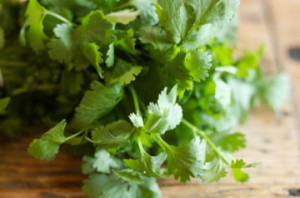While traveling, I love to experience the foods particular to a region. During our most recent trip to Los Cabos, Mexico, I had the privilege of sitting in on an authentic Mexican cooking class and discovered the art of making ceviche (it’s really quite simple). The key to Authentic Mexican Ceviche lies in one ingredient in particular.
Meet cilantro.
Fresh cilantro is a culinary tradition not only in Mexican ceviche, but in tacos, burritos, salsas, beans, salads and even in breakfast omelettes.
Cilantro looks a lot like Italian flat leaf parsley, and is sometimes called Chinese parsley (it is native to the Mediterranean and Middle Eastern regions). In fact, both parsley and cilantro are members of the carrot family. But the similarity between the two herbs in feature is accompanied by a disparity in taste. Parsley is a mild herb, while cilantro evokes a culinary controversy. There are the lovers and there are the haters.
And if you are a cilantro “hater”, you may know of the website ihatecilantro.com and numerous anti-cilantro facebook groups (seriously!).
According to my high school biology teacher, liking or hating cilantro is a genetic trait. In fact, scientific evidence to date dictates that he may have been right.
But regardless of whether genetics is a factor in the likeability of the herb, one thing that even haters can’t ignore is cilantro’s powerful health benefits.
Cilantro has been shown to be:
– High in anti-oxidants
– Rich in chlorophyll
– Beneficial to the digestive system, stimulating the secretion of pancreatic enzymes for optimal digestion and nutrient absorption
– Anti-microbial
– Anti-cancerous
– A factor in lowering triglycerides and total cholesterol levels
– Liver-supportive, enhancing the liver’s detoxification enzymes
– A natural chelator, helping to remove heavy metals from the body
Last year, I had mercury amalgam fillings removed, and was on a cilantro protocol for three months to support my liver in removing any remaining metals.
Cilantro is also popularly used during whole food cleanses like the one we currently offer. It provides powerful herbal support for the liver in the removal of toxins during detoxification.
You may be surprised that cilantro is also known as coriander, a green annual plant with seeds that are used as a spice. The leaves of the plant should be crisp and green when purchased. And, remember to store cilantro in the fridge. I like to place the cilantro bunch in a mug of water (like flowers in a vase) and cover the leaves with a plastic produce bag. It will last up to two weeks.
In addition to Mexican dishes, cilantro can be used in Asian, South American or Thai foods. It can be added to dressings or sprinkled on foods as a garnish; it can be used in cooking fish, chicken, and beans. Or, try cilantro in place of parsley in your favorite smoothie.
I’ve read that the aversion to cilantro may be related to smell. Try holding your nose while adding it to a favorite dish or smoothie, and let me know if that helps!




